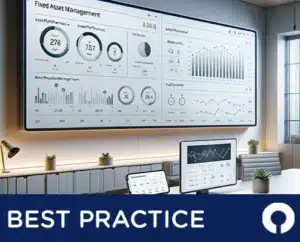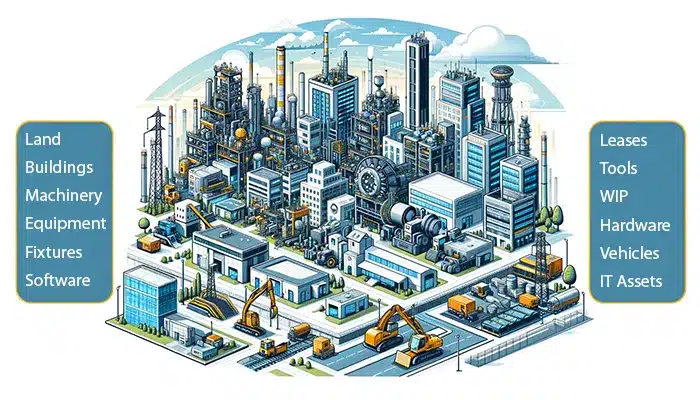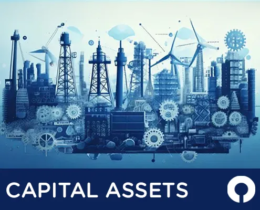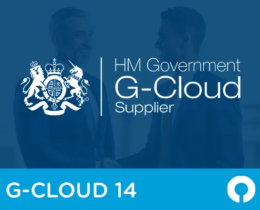Best Practices in Fixed Asset Management
Discover the key strategies to optimize your asset lifecycle and cut costs.

Discover the key strategies to optimize your asset lifecycle and cut costs.

Fixed asset management is critical to company financial reporting and planning, and for many, it is also key to optimising asset utilisation. This article outlines best practices and helpful tips for saving you time, reducing costs and improving accuracy when managing fixed assets.
Managing fixed assets requires more than updating your asset register at the period end as an administrative box-ticking exercise. It is essential for accountants, facilities managers, and asset managers. It will help track asset life cycles, reduce costs, and maintain safety and compliance if done effectively. With solutions like FMIS Fixed Assets, managing the intricacies of fixed assets becomes streamlined, ensuring businesses can get the most out of their investments.
Let’s clarify what we mean by Fixed Asset Management, as it is often used interchangeably with similar asset management terms. Fixed Asset Management involves comprehensively tracking and maintaining all company fixed assets and investments. It is distinct from:

Efficient fixed asset management relies heavily on effective planning. Implementing a successful fixed asset management solution will require planning to deliver a process that meets the needs of the whole business. One of the most common reasons asset management projects fail is through a lack of adoption across the entire organisation, and this will usually happen when the chosen system is not suitable for one or more users within the business. It will not always be possible to deliver a single solution to meet all needs, but it is important to plan how chosen solutions will fit into the overall approach to managing fixed assets.
A strategy encompassing all business areas ensures that assets are managed efficiently from the get-go, preventing the pitfalls of siloed decision-making. A comprehensive fixed asset management plan can create a harmonious balance between various business functions, improving operational efficiency and financial gains.
Starting with an accurate asset register is essential to effectively managing your fixed assets. The starting point of implementing any new system will be to import or build your asset register. If you are starting from scratch, then it might make sense to implement your system first and complete the audit using the tools provided. A good asset management system will have features to simplify completing an audit, such as making bulk changes and tagging your assets for easy identification later on.
Surprisingly, many businesses operate with inaccurate registers, leading to ghost assets and financial discrepancies. Ghost assets skew fixed asset reporting and can significantly impact asset deployment. An asset cannot be effectively utilised if it doesn’t exist or cannot be found.
An audit can seem daunting if you have many assets but few resources. In this case, outsourcing your initial audit to one of the many providers specialising in stock takes and asset inventories may be worth outsourcing. Pricing is usually based on the number of assets, locations, and details to be recorded.
It is worth checking the accreditations of providers as they will vary across different industries and countries. Key UK accreditations for stock check or asset inventory providers may include ISO 9001:2015, ISO 55001:2014, RICS, CIPFA, NPORS, IAM Membership, SAFE Contractor, and Constructionline, ensuring quality, safety, and professional standards.
Fixed asset tracking is more than just knowing what you have; it’s about understanding asset performance and value over time. Distinct from, yet vital to, fixed asset management, effective tracking ensures real-time data accuracy, feeding into financial assessments and operational readiness. The essentials of a formal fixed asset tracking system, including schedules, documentation, and technology use, all contribute to a more financially sound asset management approach.
One key challenge asset managers will face when tracking fixed assets is the tendency for the business to maintain multiple asset registers. This will lead to inconsistency in how different departments track assets, but perhaps more importantly, it will lead to fragmented data and data duplication. The lack of an authoritative data source will make it difficult or impossible to complete an accurate fixed asset reconciliation.
While fixed assets management and accounting fundamentals may have remained fairly constant, the technology available to fixed assets managers has developed rapidly in recent years. Most fixed asset management software supports a range of features that make efficient fixed asset accounting and tracking achievable for any business.
Cloud Hosting: Most specialist systems today support or are exclusively cloud-based (SaaS). The cloud allows multiple users to update a central asset record from anywhere in the world using a single system. This alone has been transformative for larger organisations, which can now consolidate multiple fixed asset registers under a single solution.
Mobile: Whilst you may never effectively manage your company’s financial reports from your phone, mobile applications are great for lifecycle management or conducting a physical inventory over multiple sites. Many apps will allow you to use the phone camera as a barcode scanner, replacing expensive scanners.
Automated Solutions: Specialist inventory management and accounting software offers many benefits over spreadsheets, but one of the biggest is automation. Human error is inevitable when working with manual solutions. The most common reason clients give for implementing the FMIS Software is the overhead and inefficiency of spreadsheets for managing daily operations and ensuring correct accounting procedures. It simply isn’t cost-effective.
Internet of Things (IoT): Asset connectivity has transformed asset data collection and use. Automated collection can help prevent unplanned downtime, determine the estimated lifespan and show real time location when tracking assets like fleet and equipment.
As helpful as new technology can be, it is important to quantify the real benefit and applicability of any new tool. GPS enabled asset tags might be great for tracking field equipment, but are they really worthwhile for office computer equipment?
Reporting requirements may look very different for each business function within the company. Whether tracking maintenance costs and asset performance for operations or posting accumulated depreciation to the company’s balance sheet for finance, accuracy and availability require a combination of collecting the necessary information and the reporting tools to generate the reports.
Specialist software will automate many of your regular reports. Unless you are dealing with a small number of assets in a single location, the cost of the software can usually be justified by improving efficiency through proper management. It should reduce costs in the long run and offer much greater accuracy than unreliable methods like spreadsheets.
Automation plays a key role but will only be effective to the extent that your data is accurate and complete. Reporting metrics determine the information you must collect over the asset life cycle.
Getting help from an expert will help you at every stage of the process, but it is essential early on in the planning phases. Changing processes and correcting mistakes after they happen always takes much longer than investing the time and expense to get it right at the outset. Even a short conversation before planning is helpful, but ideally, you should build a long-term relationship with either your software provider or an external consultant.
In recap, we have looked through six key elements of effective fixed asset management, each playing a pivotal role in a successful management strategy. By planning ahead, starting with a full audit, employing effective asset tracking, leveraging technology, producing informative reports, and seeking expert advice, you can save time and money.
Planning: Implement a comprehensive planning process to ensure the fixed asset management system meets the needs of the entire business.
Audits: Begin by establishing an accurate asset register to lay the foundation for effective fixed asset management.
Tracking: Ensure real-time accuracy of asset data to improve financial assessments and operational readiness.
Technology: Utilise technology and software to enhance efficiency and accuracy.
Reporting: Automate reporting to reflect accurate asset management and improve decision-making.
Expert Advice: Consult with experts early in the planning process to ensure the success of your fixed asset management system.
With over 35 years of experience, FMIS is at the forefront of providing asset management solutions that deliver results. We invite you to reach out and discover how our expertise can benefit your organization.
 /wp-content/uploads/2024/12/Depreciation-Review-495x400-1.webp400495John de Robeck/wp-content/uploads/2016/07/FMIS-logo-340x156.pngJohn de Robeck2024-12-18 15:04:412025-02-13 16:03:51What is a Depreciation Review and when is it needed?
/wp-content/uploads/2024/12/Depreciation-Review-495x400-1.webp400495John de Robeck/wp-content/uploads/2016/07/FMIS-logo-340x156.pngJohn de Robeck2024-12-18 15:04:412025-02-13 16:03:51What is a Depreciation Review and when is it needed? /wp-content/uploads/2024/12/Capital-Asset-Management-495x400-1.webp400495John de Robeck/wp-content/uploads/2016/07/FMIS-logo-340x156.pngJohn de Robeck2024-12-09 10:09:252025-02-13 16:03:50What is Capital Asset Management Software? (CAM)
/wp-content/uploads/2024/12/Capital-Asset-Management-495x400-1.webp400495John de Robeck/wp-content/uploads/2016/07/FMIS-logo-340x156.pngJohn de Robeck2024-12-09 10:09:252025-02-13 16:03:50What is Capital Asset Management Software? (CAM) /wp-content/uploads/2024/12/G-Cloud-14-approved-supplier-495x400-1.webp400495John de Robeck/wp-content/uploads/2016/07/FMIS-logo-340x156.pngJohn de Robeck2024-12-05 16:00:312025-02-13 16:03:49G-Cloud 14 Approved Supplier
/wp-content/uploads/2024/12/G-Cloud-14-approved-supplier-495x400-1.webp400495John de Robeck/wp-content/uploads/2016/07/FMIS-logo-340x156.pngJohn de Robeck2024-12-05 16:00:312025-02-13 16:03:49G-Cloud 14 Approved Supplier /wp-content/uploads/2024/10/Optimising-Fixed-Asset-Lifecycles-495x400-1.webp400495John de Robeck/wp-content/uploads/2016/07/FMIS-logo-340x156.pngJohn de Robeck2024-10-25 13:08:502025-02-13 16:03:48Optimising Fixed Asset Lifecycles: From Acquisition to Disposal
/wp-content/uploads/2024/10/Optimising-Fixed-Asset-Lifecycles-495x400-1.webp400495John de Robeck/wp-content/uploads/2016/07/FMIS-logo-340x156.pngJohn de Robeck2024-10-25 13:08:502025-02-13 16:03:48Optimising Fixed Asset Lifecycles: From Acquisition to DisposalFMIS Ltd
167b John Wilson Business Park
Whitstable
Kent
CT5 3RA
United Kingdom
Phone:+44 (0) 1227 773003
Fax:+44 (0) 1227 773005
Sales:sales@fmis.co.uk
Support:support@fmis.co.uk

 SoftwareSuggest Awards – FMIS recognised for easy implementation
SoftwareSuggest Awards – FMIS recognised for easy implementation| Cookie | Duration | Description |
|---|---|---|
| cookielawinfo-checkbox-advertisement | 1 year | Set by the GDPR Cookie Consent plugin, this cookie is used to record the user consent for the cookies in the "Advertisement" category . |
| cookielawinfo-checkbox-analytics | 11 months | This cookie is set by GDPR Cookie Consent plugin. The cookie is used to store the user consent for the cookies in the category "Analytics". |
| cookielawinfo-checkbox-functional | 11 months | The cookie is set by GDPR cookie consent to record the user consent for the cookies in the category "Functional". |
| cookielawinfo-checkbox-necessary | 11 months | This cookie is set by GDPR Cookie Consent plugin. The cookies is used to store the user consent for the cookies in the category "Necessary". |
| cookielawinfo-checkbox-others | 11 months | This cookie is set by GDPR Cookie Consent plugin. The cookie is used to store the user consent for the cookies in the category "Other. |
| cookielawinfo-checkbox-performance | 11 months | This cookie is set by GDPR Cookie Consent plugin. The cookie is used to store the user consent for the cookies in the category "Performance". |
| CookieLawInfoConsent | 1 year | Records the default button state of the corresponding category & the status of CCPA. It works only in coordination with the primary cookie. |
| PHPSESSID | session | This cookie is native to PHP applications. The cookie is used to store and identify a users' unique session ID for the purpose of managing user session on the website. The cookie is a session cookies and is deleted when all the browser windows are closed. |
| viewed_cookie_policy | 11 months | The cookie is set by the GDPR Cookie Consent plugin and is used to store whether or not user has consented to the use of cookies. It does not store any personal data. |
| Cookie | Duration | Description |
|---|---|---|
| CONSENT | 2 years | YouTube sets this cookie via embedded youtube-videos and registers anonymous statistical data. |
| _ga | 2 years | The _ga cookie, installed by Google Analytics, calculates visitor, session and campaign data and also keeps track of site usage for the site's analytics report. The cookie stores information anonymously and assigns a randomly generated number to recognize unique visitors. |
| _gat_UA-48954022-1 | 1 minute | A variation of the _gat cookie set by Google Analytics and Google Tag Manager to allow website owners to track visitor behaviour and measure site performance. The pattern element in the name contains the unique identity number of the account or website it relates to. |
| _gid | 1 day | Installed by Google Analytics, _gid cookie stores information on how visitors use a website, while also creating an analytics report of the website's performance. Some of the data that are collected include the number of visitors, their source, and the pages they visit anonymously. |
| Cookie | Duration | Description |
|---|---|---|
| VISITOR_INFO1_LIVE | 5 months 27 days | A cookie set by YouTube to measure bandwidth that determines whether the user gets the new or old player interface. |
| YSC | session | YSC cookie is set by Youtube and is used to track the views of embedded videos on Youtube pages. |
| yt-remote-connected-devices | never | YouTube sets this cookie to store the video preferences of the user using embedded YouTube video. |
| yt-remote-device-id | never | YouTube sets this cookie to store the video preferences of the user using embedded YouTube video. |
